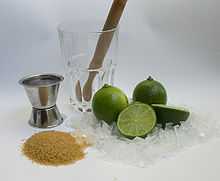Caipirinha
| IBA Official Cocktail | |
|---|---|
 | |
| National cocktail of Brazil | |
| Type | Cocktail |
| Primary alcohol by volume | |
| Served | On the rocks; poured over ice |
| Standard garnish |
sugar cane, lime(ingredient)[1] |
| Standard drinkware |  |
| IBA specified ingredients* | |
| Preparation | Place lime and sugar into old fashioned glass and muddle (mash the two ingredients together using a muddler or a wooden spoon). Fill the glass with crushed ice and add the Cachaça.[2] |
| Notes | A wide variety of fresh fruits can be used in place of lime. In the absence of cachaça, vodka can be used, making a caipiroska.[3] |
Caipirinha (Portuguese pronunciation: [kajpiˈɾĩȷ̃ɐ]) is Brazil's national cocktail, made with cachaça (pronounced: [kaˈʃasɐ]) (sugar cane hard liquor), sugar and lime.[1] Cachaça is Brazil's most common distilled alcoholic beverage (also known as Pinga or Caninha). Both rum and cachaça are made from sugarcane-derived products. Specifically with cachaça, the alcohol results from the fermentation of sugarcane juice that is afterwards distilled.
History
There are many stories about the caipirinha's origin. The best known is one that begins around 1918, in the state of São Paulo. According to information, the caipirinha as we know it today would have been created from a popular recipe made with lemon, garlic and honey, indicated for patients of Spanish flu—and which, today, is still used to cure small colds. As it was quite common to put a little alcohol in any home remedy in order to expedite the therapeutic effect, rum was commonly used. "Until one day someone decided to remove the garlic and honey. Then added a few tablespoons sugar to reduce the acidity of lime. The ice came next, to ward off the heat," explains Carlos Lima, executive director of IBRAC (Brazilian Institute of Cachaça).[4][5]
Popularity
The caipirinha is the strongest national cocktail of Brazil,[6] and is imbibed in restaurants, bars, and many households throughout the country. Once almost unknown outside Brazil, the drink has become more popular and more widely available in recent years, in large part due to the rising availability of first-rate brands of cachaça outside Brazil.[7] The International Bartenders Association has designated it as one of their Official Cocktails.[8]
Name
The word caipirinha is the diminutive version of the word caipira, which refers to someone from the countryside, being an almost exact equivalent of the American English hillbilly or the Lowland Scots teuchter. The word may be used as either a masculine or a feminine noun, but when referring to this drink it is only feminine (usage of diminutives is common in Brazil). In the Brazilian vocabulary, the word caipirinha is mostly associated with the drink itself rather than the class of person.
Variations
- The term caipirinha is sometimes used to describe any cachaça-and-fruit-juice drink (e.g. a passionfruit caipirinha, kiwifruit caipirinha or strawberry caipirinha).
- Caipifruta is a very popular caipirinha drink in Brazil, consisting of cachaça, crushed fresh fruits (either singly or in combination), and crushed ice. The most popular fresh fruits used to create caipifrutas are tangerine, lime, kiwifruit, passion fruit, pineapple, lemon, grapes, mango, cajá, and caju (cashew fruit).
- Caipisake (made with sake instead of cachaça) is also becoming increasingly popular, most commonly made with strawberries or kiwifruit.[citation needed]
- Caipiroska (made with vodka instead of cachaça). Very popular in Finland and Sweden.
Derivations
There are many derivations of caipirinha in which other spirits substitute for cachaça. The most well known include:
- The Caipivodka (also known as Caipiroska, Caipiroshka or Caipirovka), in which vodka substitutes for cachaça.
- The Caipiroska Negra, Black Caipiroshka or Caipiblack is made with black vodka instead of cachaça.
- Caipiríssima is a caipirinha made with rum instead of cachaça; the word was coined for an advertisement for a popular rum brand in the late '70s.
- Caipifruta is a variation made with cachaça and other fruits instead of lime, typically found in tourist areas.
- CaipirItaly is a variation from Italy. It's made using Campari instead of cachaça.[citation needed]
- Sakeirinha or Caipisakê is a version made with sake.[citation needed]
- Caipinheger is another variation made using Steinhäger.[citation needed]
- Morangoska is a Portuguese variation made using strawberries instead of lime.[9]
- Caipirão is another Portuguese variation made using Licor Beirão instead of cachaça. Beirão liquor is very sweet, so no sugar is used.[10]
See also
- Cachaça
- Cocktails with cachaça
- List of cocktails with cachaça
- Daiquiri – similar Cuban cocktail
- Ti'Punch – similar French Caribbean cocktail
- List of Brazilian dishes
- Sour (cocktail)
References
- ↑ 1.0 1.1 http://www6.senado.gov.br/legislacao/ListaPublicacoes.action?id=237488
- ↑ http://www.alcomixer.com/recipe/caipirinha
- ↑ http://www.maria-brazil.org/caipirinha.htm
- ↑ Casa e Jardim - NOTÍCIAS - A história da caipirinha at the Wayback Machine (archived November 17, 2011)
- ↑ http://www.drinquepedia.com/drinques/historia?drinque=146
- ↑ Mackay, Jordan (August 10, 2006). "Made in Brazil". 7x7 Magazine..
- ↑ Willey, Rob (February 2006). "Everyday with Rachael Ray". Cane and Able. Retrieved 2007-01-14. "The caipirinha—a sour-sweet combination of crushed limes, sugar and cachaça—has become the darling of American bartenders, and first-rate cachaça is at last finding a place on American liquor-store shelves."
- ↑ "International Bartenders Association". IBA. 2005-2007. Retrieved 2007-04-14.
- ↑ "Receita de Morangoska". SaborIntenso. 2005-2007. Retrieved 2012-06-01.
- ↑ "Caipirão Promotional website". Caipirão. 2005-2007. Retrieved 2012-06-01.
External links
| Wikimedia Commons has media related to Caipirinha. |
 Caipirinha at Wikibooks
Caipirinha at Wikibooks
| ||||||||||||||



